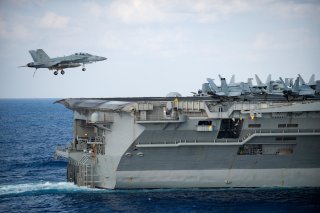Why U.S. Navy Aircraft Carriers Aren't Obsolete Just Yet
Expert: "That is why China wants one," said Fabey. "These are the ships that can keep trade lanes open and this is why until at least the end of the century you'll continue to see these big deck carriers."
Earlier this month the acting Secretary of the Navy Thomas Modly told reporters that he was uncertain if the U.S. Navy would be building any additional Ford-class aircraft carriers. The USS Gerald R. Ford is undergoing post-delivery tests and trials, while the USS John F. Kennedy, which was christened last year, is more than 70% complete. Construction has started on the USS Enterprise, while the material is being procured for the USS Doris Miller, with the final vessel set to be completed in 2032.
Previously the plan had been to have a total of 10 Ford-class carriers built through 2058. Even with a reduced number, the Navy's flattops will certainly remain the queens of the sea for decades to come.
The reason is that the aircraft carrier can do what no other ship can do. It is far more than just a floating runway for naval aircraft, it is a forward base of operations and a military vessel that can address civilian emergencies such as natural disasters.
"That is absolutely true," said Brad Curran, industry principal for aerospace, defense and security at Frost & Sullivan.
"The nuclear-powered ones can even power a small city if needed to, and instead of fighter aircraft the flight deck can be equipped with helicopters and unmanned aerial vehicles to provide disaster relief," Curran told The National Interest. "The carriers also have extensive hospitals and can transport U.S. Marines to provide security. These ships can be stocked with tons and tons of food, water and medicine and almost anything else that needs to be transported."
While the U.S. Navy has already pledged to send a hospital ship to each coast to deal with the coronavirus outbreak, carriers could also be called up.
"If things got really bad in New York City a carrier could be emptied of weapons and ammunition, and stocked to provide the needed resources," added Curran.
"These are ideal for helping after a natural disaster," explained Mike Fabey, Americas Naval reporter for Jane's.
"There are medical facilities that could handle the needs of a small town," Fabey told The National Interest.
Floating Strength
Throughout the Cold War, the U.S. Navy was able to flex its proverbial muscles via its carriers. As an example, the USS Dwight D. Eisenhower (CVN 69) Carrier Strike Group is composed of roughly 7,500 personnel and is one of the largest operation units of the U.S. Navy, and is a flexible force that can operate both in confined waters or in the open navy, day or night and in any weather condition.
"Nothing strikes fear into an enemy like when a carrier is on the way," said Curran.
However, the carrier isn't exactly a floating fortress.
"They are vulnerable to anti-ship missiles and shore batteries, and we have to worry now that our adversaries have satellite capability as well as hypersonic weapons," warned Curran. "There is also the issue of quiet diesel submarines that can be hard to detect and these could be armed with improved torpedoes.
Carriers alone would thus be a vulnerable floating runway.
"Without its air wing a carrier is really nothing," said Fabey.
"This is also why carriers are part of a strike group – the submarines and destroyers need to screen for the carrier and protect it," noted Curran.
However, the right weapon at the right place can be very dangerous.
"A major power with the right weapon could take out a carrier," added Fabey. "But doing so would mean outright war."
However, in addition to being able to perform as a forward base of operations today, the carrier remains that ultimate show of strength. Throughout the latter half of the 20th century the United States was the only power that could deploy carriers around the world.
In these chaotic times, the carrier could remain that show of strength.
"That is why China wants one," said Fabey. "These are the ships that can keep trade lanes open and this is why until at least the end of the century you'll continue to see these big deck carriers."
Peter Suciu is a Michigan-based writer who has contributed to more than four dozen magazines, newspapers and websites. He is the author of several books on military headgear including "A Gallery of Military Headdress," which is available on Amazon.com.

